Real World DirectX 10 Performance: It Ain't Pretty
by Derek Wilson on July 5, 2007 9:00 AM EST- Posted in
- GPUs
DirectX 9 vs. DirectX 10
Here we'll take a closer look at some of the scaling differences between DirectX 9 and DirectX 10 on current hardware under current drivers with Company of Heroes and Lost Planet.
First up is a look at relative scaling between cards under each API. The idea is to see whether cards that perform better under DX9 also perform better under DX10 (and vice versa). This will only give us a glimpse at what could happen going forward, as every game (and every implementation of that game) will be different.
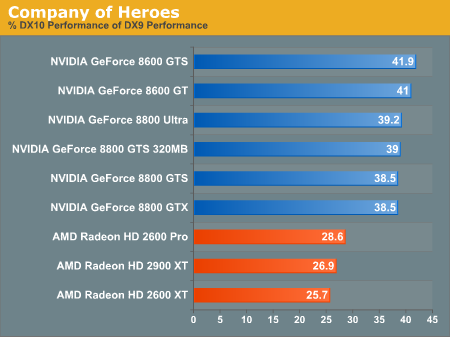
For Company of Heroes, we see huge performance drops in moving to DirectX 10 from DirectX 9. The new lighting and shadowing techniques combined with liberal geometry shader use are responsible for at least halving performance when running the more detailed DX10 path. NVIDIA seems to handle the new features Relic added better than AMD. These results are especially impressive remembering that NVIDIA already outperformed AMD hardware under DX9.

Lost Planet is a completely different animal. With Capcom going for a performance boost under DX10, we can see that they actually succeeded with the top of the line NVIDIA cards. There isn't much else enticing about the DX10 version of Lost planet, and it's clear that AMD's drivers haven't been optimized to tackle this game quite yet.
Next we want to take a look at AA scaling difference between DirectX 9 and DirectX 10. Can we expect less impact from AA on one API or the other? Let's take a look.
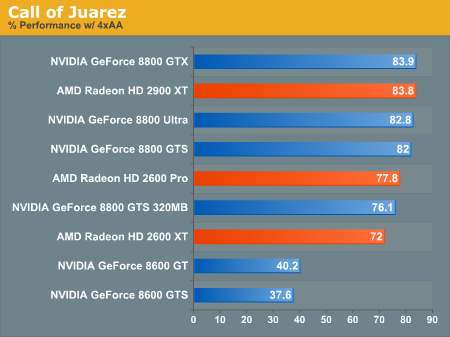
Under Call of Juarez, our low-end NVIDIA cards suffer from a huge drop in performance when AA is enabled. This is likely due to the fact that they can't handle either the bandwidth or the shader requirements of Techland's HDR correct AA. The higher end parts seem to handle the AA method fairly well, though certainly NVIDIA would be happier if the retained their hardware AA advantage.
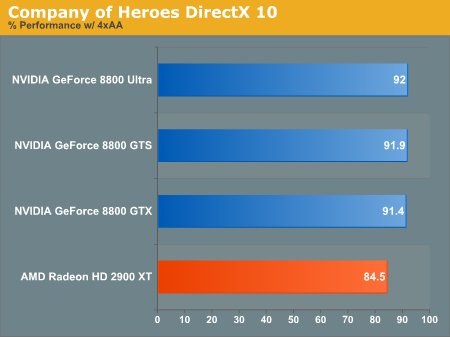
For our DX10 Company of Heroes test, which does use hardware MSAA resolve where available, AMD hardware scales much worse than NVIDIA hardware.
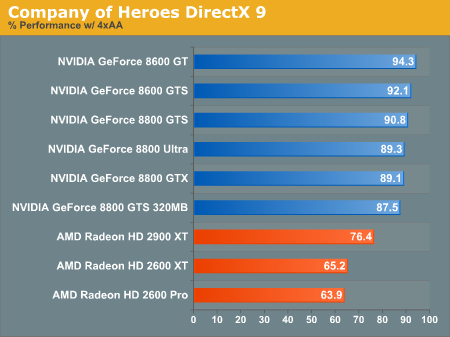
All of our cards scale worse under DX9 when enabling 4xAA than under DX10. While we don't have enough information to really understand why that is under Company of Heroes, it is certainly interesting to see some sort of across the board performance advantage for DX10 (even if it is in a round about way).
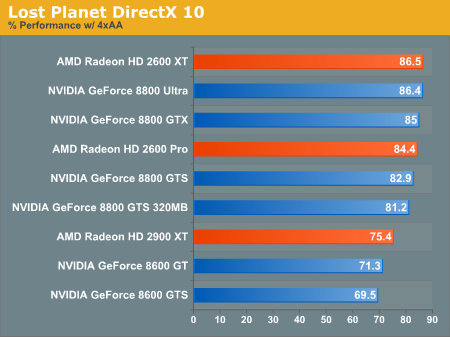
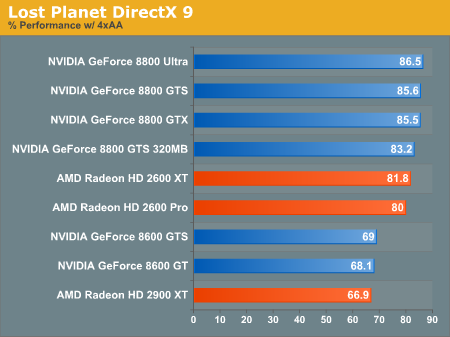
Lost Planet, with its attempt to improve performance by moving to DX10, delivers very similar performance impact from AA in either DX9 or DX10. Again we see a very slight scaling advantage in favor of DX10 (especially with AMD hardware), but nothing life changing.
Here we'll take a closer look at some of the scaling differences between DirectX 9 and DirectX 10 on current hardware under current drivers with Company of Heroes and Lost Planet.
First up is a look at relative scaling between cards under each API. The idea is to see whether cards that perform better under DX9 also perform better under DX10 (and vice versa). This will only give us a glimpse at what could happen going forward, as every game (and every implementation of that game) will be different.

For Company of Heroes, we see huge performance drops in moving to DirectX 10 from DirectX 9. The new lighting and shadowing techniques combined with liberal geometry shader use are responsible for at least halving performance when running the more detailed DX10 path. NVIDIA seems to handle the new features Relic added better than AMD. These results are especially impressive remembering that NVIDIA already outperformed AMD hardware under DX9.

Lost Planet is a completely different animal. With Capcom going for a performance boost under DX10, we can see that they actually succeeded with the top of the line NVIDIA cards. There isn't much else enticing about the DX10 version of Lost planet, and it's clear that AMD's drivers haven't been optimized to tackle this game quite yet.
Next we want to take a look at AA scaling difference between DirectX 9 and DirectX 10. Can we expect less impact from AA on one API or the other? Let's take a look.

Under Call of Juarez, our low-end NVIDIA cards suffer from a huge drop in performance when AA is enabled. This is likely due to the fact that they can't handle either the bandwidth or the shader requirements of Techland's HDR correct AA. The higher end parts seem to handle the AA method fairly well, though certainly NVIDIA would be happier if the retained their hardware AA advantage.

For our DX10 Company of Heroes test, which does use hardware MSAA resolve where available, AMD hardware scales much worse than NVIDIA hardware.

All of our cards scale worse under DX9 when enabling 4xAA than under DX10. While we don't have enough information to really understand why that is under Company of Heroes, it is certainly interesting to see some sort of across the board performance advantage for DX10 (even if it is in a round about way).


Lost Planet, with its attempt to improve performance by moving to DX10, delivers very similar performance impact from AA in either DX9 or DX10. Again we see a very slight scaling advantage in favor of DX10 (especially with AMD hardware), but nothing life changing.










59 Comments
View All Comments
misaki - Thursday, July 5, 2007 - link
So Nvidia and AMD actually complained about their "mainstream" parts being below par?It sounds to me like they are seriously out of touch. Media center PCs will get their 8400 and 2400 cards for h264 acceleration. Gamers with lots of money will buy those $400+ cards as usual. But your average gamer in the $200 market is stuck with junk that is unplayable for dx10 games and performs like previous gen hardware that just barely makes the grade for current games already on the market.
What is so hard to understand?
MadBoris - Thursday, July 5, 2007 - link
I'm glad that some of the things that were said in the article, are starting to be said. DX10 reminds me of Physx, great concept but can't possibly succeed due to certain hurdles in the technology being able to actually take off. Unfortunately DX10 also isn't going to be what we all hoped it would be in real performance, video drivers are not the only reason.There is something real counterintuitive with quality native DX10 rendering support.
There is very little incentive for a developer to produce a good DX10 renderer when developers have DX9 support on Vista along with many of their real current goals of console support for more customer base. With only so many hours a day, console support is much more lucrative with new people having access to buying a title, that will also actually run just fine with only DX9 on a Vista platform, never needing or really benefitting from DX10.
The costs of making DX10 games outweigh the benefits, and the benefits aren't currently that palpable in the first place. Furthermore, actual DX10 performance will rarely ever be all that positive, something that is too early to prove, but rather negative even though apples to apples DX9 to DX10 comparisons cannot be made.
As to the low end parts, it's just marketing, theirs no "real" value DX10 for $100 -$150 for gaming. If people want a good video value purchase for games, $200 is where the good quality/price starts and it's mostly in a previous generation, not some value card for $150. Whether we agree with that price point being 'worth it' is another matter altogether and is purely personal preference. I don't know why Nvidia or ATI even introduced low end DX10 compatible hardware when customers will only get angry at developers or video mfr's for the blunder of underpowered hardware for high end game titles. This low end DX10 hardware mystified me. it was either going to slow down DX10 progress or have to be ignored. It seems obvious that all high end games will have to pretty much ignore the low end parts for achieving acceptable framerates with DX10 for new eye candy titles. They should have left DX10 out entirely in low end, but they had to include it because of competition between AMD/Nvidia, neither wanted to leave the other with a marketing advantage of saying, look we have DX10. DX10 with it's lofty goals of being able to render more in a scene and produce even greater quality eyecandy is at odds with low price. Higher quality rendering will always be at odds with low price, they are mutually exclusive. Low price never is going to give you good performance and quality, people should really start being realistic as to what they are paying for at a $100 - $150 price point, it's a consumer expectations problem. Low end hardware will work fine for games like Sims and those games will target low end hardware, but not high end games for higher resolutions and decent frame rates.
In the end, with future goggles on I think the picture is becoming quite clear that DX10 will become one of the DX API's that becomes mainly skipped (if a decent DX successor becomes available in next few years). The only time it will really make sense to go above DX9 native support is when Vista saturates >%85 gaming market share. In the several years that that will take, DX11 or higher should be available and will be superior to DX10, so DX10 in hindsight will really end up being just a marketing ploy to upgrade to Vista, little more.
Glad the mask is starting to come off and more people are being able to see the picture clearer that making any purchases around DX10 with a GPU or OS is silly and bound to cause frustration.
strafejumper - Thursday, July 5, 2007 - link
i upgraded recently - but ended up only spending under $300 for a core2duo systemthis is why - people were saying get a DX10 card - future proof
i decided to keep my old agp card because i felt real dx10 games and real dx10 hardware were not here yet.
i'm happy i made i feel the right choice and didn't spend money on new psu, sata drives etc. so i could have a $$$ dx10 card only to play call of juarez at 14 fps.
stromgald - Thursday, July 5, 2007 - link
I have to agree. I was considering trying to get an 8600 for my SFF PC, but after looking at this, I'm probably going to hold off until the next generation. HTPC and SFF PCs just can't handle the heat an 8800 series generates, and I want at least playable DX10 performance.jay401 - Thursday, July 5, 2007 - link
Seriously, F them. It's pathetic they're trying to pawn off half-assed hardware as "mid-range enthusiast" parts when they can't even perform as good as the mid-range from the previous generation. Jerks.
jay401 - Thursday, July 5, 2007 - link
Another new article showing how DX10 Vista performance propaganda is garbage.Gotta love people who try to act superior b/c they bought Vista for gaming when all it does is suck up more system resources and uses DX10, the combination of which will easily inhibit performance on equivalent hardware.
BigLan - Thursday, July 5, 2007 - link
"They both argued that graphics cards are no longer just about 3D, and additional video decode hardware and DX10 support add a lot of value above the previous generation."Yeah, I don't buy into this either. I've pretty much given up on 'video decode,' be it avivo or purevideo. You end up stuck with using a specific product, rather than ati or nvidia opening the features for any developer to access. Right now, it's only useful with the latest windvd, powerdvd or nero but you have to hope your driver version is the right one, and doesn't (and probably never will) work for x264 or xvid content.
Purevideo is horribly branded by nvidia - is it card features that everyone has access to, or do you have to buy it from them? And has ati actually released their avivo video converter to the public? Could I use it to compress some of my recorded tv shows from mpeg to xvid?
Maybe this is like the mpeg2 decoder situation was in 98/99, in which case we should just wait for cpu speeds to increase and mean that we don't need video decode acceleration.
titan7 - Thursday, July 12, 2007 - link
I agree. How much quicker would things be if all the video transistors were spent on more shader processors? I want my video card for video games. I want my dvd player for movies.vailr - Thursday, July 5, 2007 - link
Comparing mid-range DX10 cards:(lowest prices found via froogle.com; shipping not included)
Radeon 2600XT 256Mb ~$145
http://www.ewiz.com/detail.php?p=AT-2600XT&c=f...">http://www.ewiz.com/detail.php?p=AT-2600XT&c=f...
nVidia 8600GT 256Mb ~$100 (after $15 MIR)
http://www.newegg.com/Product/Product.asp?Item=N82...">http://www.newegg.com/Product/Product.asp?Item=N82...
How is the 2600XT worth the added $45 v. the 8600GT?
Comdrpopnfresh - Thursday, July 5, 2007 - link
I have a 7600gt oc'd to 635/800. I get 30+fps with better than default settings, with AAx2 set @ 1024x768. Why do these cards not seem to do much better (given they are @ 1280x1024)?